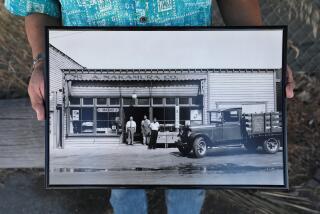Style : DESIGN : A Temple to the Past
- Share via
The elevator doors resemble a Japanese screen. The carpet is the color and texture of a grass mat. Dormitories where monks once slept are now curatorial work areas with humidity controls and a darkroom. The Japanese American National Museum, opening Friday in Little Tokyo, is a private, nonprofit repository for items documenting the Japanese-American experience--a picture bride’s basket for the voyage west; signs and tools from immigrant businesses; the toys of nisei children.
The museum is also a melange of Oriental and Occidental design. Built in 1925 as a Buddhist temple, the building was used for storage by families interned during World War II. Working from photos taken of weddings, birthdays and funerals in the sanctuary and with research by preservation architect James McElwain, the West Los Angeles design team of James and Christine Nakaoka painstakingly restored the interior. Under thick white paint in the ceremonial lobby, they discovered rough, reddish walls. (In Japan, temple interiors are red, and walls are embedded with straw, stones, wood chips and gold nuggets to catch the light.) So more than 10 pigments were blended to re-create the original shade and then tiny rock chips were blown onto the plaster.
A wood staircase leads to the old sanctuary, now an exhibit hall, where about 150 floral ceiling panels were ruined beyond repair by years of incense-burning. The Nakaokas had each one replicated, the new boards “aged” with water before painting. They also had the altar repainted, the lanterns (now glass instead of paper) refurbished and the walls reglazed, leaving a rich patina and a lightly cracked finish.
Even the offices reflect the past. Oak floors were restored, and walls were retroweled. But there are a few purely modern touches, such as the Philippe Starck bathroom light fixtures. “In some areas, we tried to re-create the original look exactly,” Christine Nakaoka says of the $5-million project. “But in other areas, we tried to reflect that the museum was opening in 1992, and so we just tried to have some fun.”






